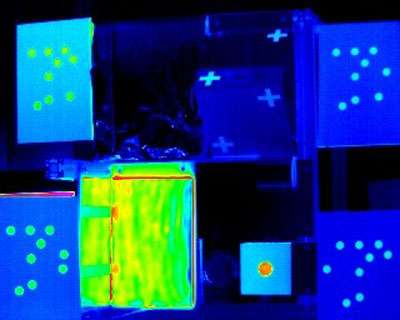New 3-D thermal imaging capability for satellites

Scientists from the National Physical Laboratory (NPL) have developed a new technique for taking 3D thermal images of satellites. The technique is being developed for prospective use at the European Space Agency's (ESA) largest vacuum facility, the Large Space Simulator (LSS). The measurements will better allow measurement data to be compared with thermal models, verifying their accuracy.
In 2009, the Temperature & Humidity Group at NPL, in collaboration with ESA, rose to this challenge by creating 2D thermal imaging system that could image inside a vacuum. Now, in 2016, as part of a second collaborative project, the consortium have done so again, developing a first-of-its-kind technology for 3D thermal imaging.
Historically, when measuring temperature, space scientists use sensors called 'thermocouples'. For an accurate, high resolution measurement, researchers would need to attach many thousands of thermocouples to each satellite. This is often impractical and can pose a significant disadvantage for space flight due to the increased weight of the satellite. Conversely, when using too few thermocouples, not enough measurement data is available to achieve high confidence and resolution for reliable model comparison.
A solution for enhanced resolution comes in the form of thermal imaging. First implemented by the team in 2D and now advanced to 3D, thermal pictures taken on the ground provide supplementary information, allowing satellite developers to model satellite behaviour before launch. Scientists can use these measurements to validate behaviour prior to launch, provided greater measurement resolution and confidence and potentially eventually reducing the number of thermocouples that need to be used.
Working with Swiss 3D measurement company PhotoCore and London-based management consultancy PSI-tran, the team at NPL has overcome these problems by implementing new, state-of-the-art features which produce accurate and traceable geometrical and thermal information from the satellite structure. The capability also compensates for the non-perfect emissivity, inter-reflections and background radiation.
"Accurately measuring the geometrical form and thermal distribution of a satellite has been a significant measurement challenge," says Dr Rob Simpson, an NPL researcher working on the project. "But we're very pleased with the early results."
The new technology will be used in satellite testing by ESA at the LSS in its European Space Research and Technology Centre, as part of its ongoing work to enhance measurement data.
"The consortium have been fantastic to work with and this has been very much a collaborative project. We're excited to see the advances that this technology will bring to this and other fields," Simpson adds.
Provided by National Physical Laboratory




















